Mimicry plants, also referred to as mesembs or mimicry succulents, are those that look like something that isn’t plant-like to avoid being eaten by animals.
They are plants that have adapted to mimic other plants, animals, or natural features in order to deceive predators into leaving them alone.
The process of how mimicry works isn’t fully understood by scientists, but it’s believed that the unusual coloring and texture of these flowers and plants are capable of tricking birds and other creatures into thinking they aren’t good sources of food.
Mimicry plants have amazing survival mechanisms that help them to blend in with their surroundings, whether it’s because they look like tree bark or an inedible plant. The term mimicry plant typically refers to flowering plants, although there are many non-flowering types of mimicry as well, including ferns and fungi.
These species use many different methods to hide from predators, so the most popular mimicry plants can be difficult to keep alive in your home garden or indoor planter.
This article will explore some of the 15 most common types of mimicry plants, how they avoid predators, and what conditions you should consider in order to keep them healthy and happy.
Overview of mimicry plants
Though many people think of flowers when they imagine plants, mimicry plants are in fact many that are great for gardeners. One such group of plants is known as mimicry because they look like other animals or insects. These types of plants have evolved to blend into their surroundings so they aren’t eaten by predators.
There are a number of different species and varieties, each with its own unique characteristics and traits. This guide will cover some of these mimicry plants, what they look like, how to care for them, and where you can find them.
Lithops as mimicry plant succulents
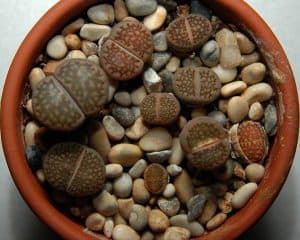
These common mimicry plants are from South Africa and come in a variety of colors and patterns. Because of their looks, they’re excellent choices for succulent decorations or terrariums. You can either plant them in a container or have them in your garden.
Since Lithops are still young, you have to keep an eye on their condition as time goes by. Keeping your mimics healthy is very important. While most people believe that all succulents are hardy, some aren’t that resilient when it comes to certain conditions.
For example, Lithops need high levels of sunlight (at least four hours) so that they could absorb enough energy through photosynthesis.
Mimicry plants examples
Mimicry plants 1 – Pleiospilos nelii ‘Royal Flush’ or Split Rock
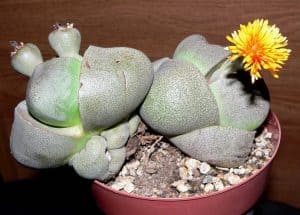
A cross between Pleiospilos nelii naivensis ‘Royal Flush’ and Pleiospilos nelii distans, Pleiospilos nelii ‘Royal Flush’ is a hybrid species of succulent found in South Africa. This mimicry plant requires plenty of sunlight to thrive, which means you’ll need to give it a south-facing window with at least five hours of sunlight per day.
Watering should be done once every two weeks, making sure that each pot has drainage holes so excess water can escape. The soil should be kept moist but not soggy, as too much moisture will cause root rot.
Fertilize every three months using a cactus fertilizer or other balanced fertilizer; do not use nitrogen fertilizers as they may damage your plant.
Mimicry plants 2 – Lapidaria margaretae (Karoo rose)
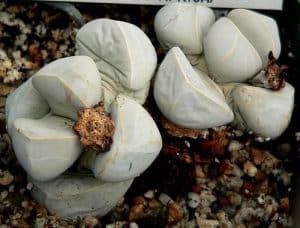
Lapidaria margaretae is a shrub with leaves similar to Mimosa pudica, it is commonly known as clapping plant. It originates from southern Africa and is frost-tolerant. It grows best in full sun or partial shade. The plant requires a well-drained soil mix and should be watered regularly during summer months but not when dormant in winter.
Fertilizer can be applied once a month during the spring and summer months using a general-purpose fertilizer diluted by half.
Mimicry plants 3 – Lithops spp. (living rocks)

This genus of succulent plants is native to South Africa and is sometimes called living rocks (lithops spp). It has a wide variety of species with many colorful, patterned forms. To create an environment that mimics its natural habitat, plant lithops in sandy soil mixed with sandstone grit and place it in bright sunlight.
This requires watering only once a month during drought periods when rainfall isn’t available. Fertilize lightly every two months using a half-strength liquid fertilizer diluted by half water. Do not over-water as doing so will cause root rot.
Keep temperatures between 50 degrees F and 70 degrees F (10 degrees C to 21 degrees C). Lithops spp. grow slowly and may take up to 10 years before blooming for the first time. The flower is usually white or yellowish in color, but some varieties have pink or red flowers.
After flowering, remove spent flowers immediately as they attract insects and are prone to fungal infection if left on too long. Once you notice new offsets forming at their base, you can separate them from parent plants for propagation purposes.
Mimicry plants 4 – Four o clock flower (Mirabilis jalapa)
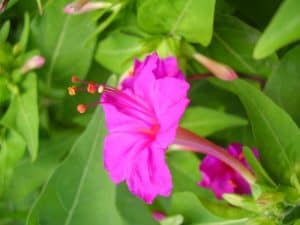
This mimicry plant, Mirabilis jalapa, is native to Costa Rica, and it produces small pink flowers between June and October. Like its namesake, Mirabilis jalapa traps insects with a sticky secretion that contains nectar.
Although not fatal to flies or other pests, bug-eating plants are considered useful garden plants for both their decorative quality and their ability to rid gardens of unwanted insects.
Flypaper plants grow well in partial shade; they need well-drained soil, warm temperatures, and regular watering in order to thrive.
They can be propagated by seeds or cuttings. However, since insecticides kill off natural predators like wasps and ladybugs, you may want to avoid using pesticides around your flypaper plant. If you choose to do so anyway, spray only when you’re certain there will be no rain within 24 hours.
Mimicry plants 5 – Fenestraria aurantiaca (Baby toes)
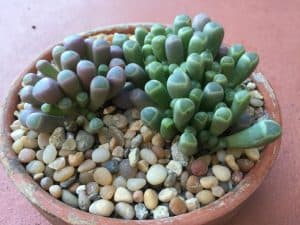
Baby toes as it’s commonly called, Fenestraria aurantiaca is a small succulent with bright yellow stems and leaves that help protect it from intense sunlight. It grows to just four inches tall and six inches wide, making it a great potted plant for apartment dwellers who don’t have much space.
Baby toes are very popular because they are easy to care for. They require little water and need full sun or partial shade. You can place them outside in warmer months but keep them indoors during wintertime if you live in an area where temperatures fall below freezing regularly.
These plants prefer sandy soil with lots of peat moss added to retain moisture and improve drainage. If you notice your baby’s toes starting to lose their color or turn brown, they may be getting too much sun or not enough water.
Mimicry plants 6 – Titanopsis calcarea (Concrete Leaf)
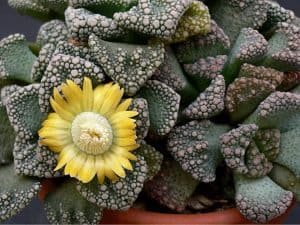
One of over 200 species of Titanopsis, Titanopsis calcarea is commonly called Stonecrop because it grows in clusters that resemble small stones and rocks. It’s high heat and drought resistant, though it does require plenty of bright light to flower indoors.
These plants grow best outdoors during the summer months and should be planted in large planters so they can spread freely. Water when the soil is dry to the touch; fertilize once a month with a water-soluble fertilizer. This plant will bloom from spring through fall if given enough sunlight. Indoors, give these houseplants as much natural sunlight as possible (at least six hours per day).
This particular variety will tolerate low humidity levels but prefers high humidity (around 50 percent) and average room temperatures between 65 and 75 degrees Fahrenheit. Outdoors, plant in full sun or partial shade; protect from frost.
Mimicry plants 7 – Rafflesia arnoldii
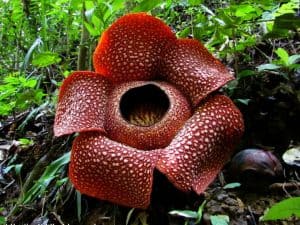
Found mostly in Indonesia, Papua New Guinea, and Sumatra, Rafflesia arnoldii is one of a number of Giant Flower species. The flower can grow up to one meter across—hence its nickname. With no leaves or stems, it’s technically not even a plant but rather an organism that lives off insects and other small animals that come near it.
While there are over 100 different types of mimicry plants, Rafflesia arnoldii has been named as one of The World’s Weirdest Wonders by National Geographic. It’s also called Corpse Flower because of its stench; some have compared it to rotting flesh.
Mimicry plants 8 – Autumn olive plants (Elaeagnus umbellata)
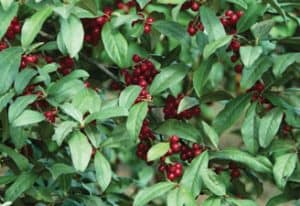
Hardy in U.S. Department of Agriculture plant hardiness zones 3 through 9, Elaeagnus umbellata is also commonly called silverberry, autumn olive plants, or spoon leaf bush. You can propagate white-spotted deerberry by taking softwood cuttings from new growth in early summer and keeping them for six to eight weeks before transplanting them outdoors.
White-spotted deerberry grows best in full sun and moist soil. It does not tolerate drought well, so be sure to water it regularly during hot weather. White-spotted deerberry produces small white flowers that are followed by red berries that attract birds and other wildlife.
Deer do not eat it because of its bitter taste. The fruit is edible if cooked but should not be eaten raw due to a high concentration of oxalates. If you live in USDA zones 7 through 10, consider planting a cultivar such as ‘Loraine Sunshine’ or ‘Sunshine Supreme’ instead, which grows up to 8 feet tall and has yellow flowers.
Mimicry plants 9 – Giant sensitive plant (Mimosa diplotricha)
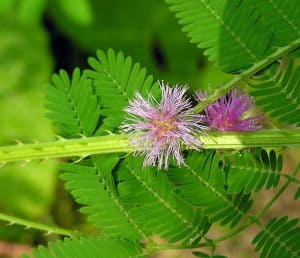
Giant sensitive plant, also known as Sensitive-plant or Mimosa diplotricha, is a small evergreen shrub that grows well in both moist and arid conditions. It’s native to Central America and Mexico and is popular in gardens because of its colorful flowers.
The roots secrete a sticky resin that’s extremely toxic, so keep giant sensitive plants away from pets and children! This particular mimicry plant attracts insects with its sweet nectar, then traps them with tiny hairs on its leaves.
This makes it appear like an insect itself—perfect for scaring off predators! In order to thrive, giant sensitive plants need plenty of sunlight and warm temperatures (above 65 degrees Fahrenheit).
They are drought tolerant once established but do best when watered regularly during their first year. To ensure your False sensitive plant survives, water only when soil is dry about an inch below ground level.
Once you see new growth and blossoms, you can reduce watering frequency slightly; still, make sure to water at least once every two weeks during the hot summer months.
Mimicry plants 10 – Blazing star plant (Liatris spicata)
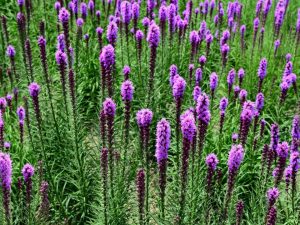
This pretty wildflower is a perennial that has been known to reach heights of three feet. It grows in midwestern regions and is native to North America.
With shades of purple and green, Liatris spicata is easy to spot among other flora, especially when it blooms during late summer. Mimicry plants are typically short-lived perennials, so expect to see your unguent plant for only two or three years before you need to replace it.
During the blazing star plant’s lifetime, you can expect vibrant flowers from July through September. The flowers are very attractive to bees and butterflies—and will also attract attention from gardeners looking for a colorful addition to their landscape! To grow an unguent plant, start by selecting a location with full sun exposure. Next, choose a well-draining soil type (e.g., sandy loam).
Finally, dig a hole about 6 inches deep to create space for roots to grow into. When planting seeds (which you should do in early spring), be sure not to bury them too deeply; instead, place them on top of the soil surface and then cover them with 1/8 inch of soil mix.
Mimicry plants 11 – Scarlet ammannia (Ammannia coccinea)
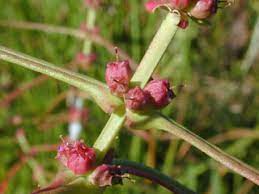
If you’re looking for an ornamental plant that requires minimal maintenance, Ammannia coccinea is a great choice. This perennial can live outside in U.S. Department of Agriculture plant hardiness zones 8 to 11, but it also thrives in containers and indoors. The flowers are crimson red with thin petals that hang down, giving them a spidery appearance.
Also known as purple false indigo, it grows up to 2 feet tall and has dark green leaves with serrated edges.
Scarlet ammannia prefers moist soil that drains well, so make sure your container has adequate drainage holes. Purple false indigo needs full sun exposure or partial shade throughout most of its growing season; however, when night temperatures drop below 60 degrees Fahrenheit (16 degrees Celsius), move it inside or under a sheltered overhang until spring arrives.
During the winter months, keep it indoors where it will need bright light and temperatures between 55 and 65 degrees F (13-18 degrees C). Water regularly during active growth periods; otherwise, allow the top 1 inch of soil to dry out between waterings. Fertilize once every two weeks during active growth periods using a balanced fertilizer such as 10-10-10.
Use caution when handling because purple false indigo contains toxic chemicals called pyrrolizidine alkaloids.
Mimicry plants 12 – Monkey face orchid (Dracula simia)
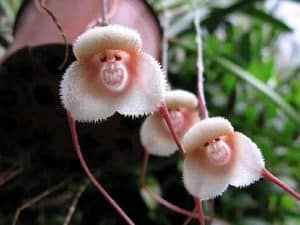
The Monkey face orchid, one of the common mimicry plants, may look like a monkey, but it’s actually an orchid that only looks like a monkey.
The unusual flower appears to have cheeks, round eyes, and a nose. Like most orchids, it requires lots of light and humidity in order to thrive. It also needs plenty of water to prevent its roots from drying out. If you’re lucky enough to own one, be sure to give it plenty of TLC!
One of nature’s strange wonders, a monkey orchid may be small, but it makes up for its size with abundance. These plants are able to reproduce through an amazing form of mimicking—they look like female wasps so that when male wasps try to mate with them, they will pollinate them instead!
What Are Mimicry Succulents?
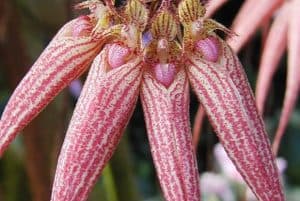
Mimicry succulents are types of succulents that mimic other objects in their environment, including sticks, leaves, animals, and even bird droppings. Because of their unique appearance, mimicry plants can add a bit of fun to your home and garden.
Whether you’re looking for something bold or just something different, there are many types of mimicry plants available in today’s market. A good example is Aechmeas/Agaves
Aechmeas/agaves come from several species, with most having an unusual shape that makes them ideal for indoor decor. Their long leaves grow from a central rosette base, which sometimes forms into spirals. The plant is often described as similar to a candelabra or dragon tail due to its dramatic form.
Agaves can be extremely slow growing; it takes around 20 years for one to reach maturity and bloom. If you’re looking for something unique, these plants are hard to beat.
They’re easy to care for once they become established and are known to live up to 50 years when cared for properly. You can also find hybrids of both aechmeas and agaves in some nurseries if you’re looking for something different than what nature has provided on its own.
How to propagate mimicry succulents?
The best way to propagate mimicry succulents is by offsetting or creating an offshoot.
Here’s how you do it: remove an offset from a parent plant and plant it in soil. Let it sit for a week or two to let it recover from being dislodged. Place in full sun (mimicry plants are sun-lovers) and water only when dry. Succulent plants can be propagated in other ways as well.
Some species have fleshy roots that will sprout new shoots if left on their own; however, they must be kept very moist during these early stages of growth. Another option is leaf propagation, which requires patience and practice. Take a leaf with a growing tip attached—the topmost part of your plant’s leaves tends to be most fruitful—and cut it into sections about one inch long.
Caring for mimicry succulents
Mimicry succulents come in an array of shapes and sizes, but most mimicry plants can be categorized into three main types. These are leaf, tuber, and ruffled-leaves plants. Not all mimicry succulents require a lot of care; they’re actually pretty easy to grow indoors. Still, it pays to learn what you’re dealing with when caring for mimicry plants; some require more maintenance than others.
Most mimicry succulents have few problems growing as houseplants. Just follow these basic guidelines: Choose a bright spot where your plant will receive at least six hours of sunlight every day.
Humidity levels should range between 40% and 80%. Soil should remain dry; use a container that has good drainage if necessary. Pests aren’t usually an issue with mimicry plants, but you may find bugs on occasion. It’s important to take action immediately when pests attack, so be sure to keep up with pest control measures.
An exception to mimicry succulent rule – Faucaria ‘Tiger Jaws’
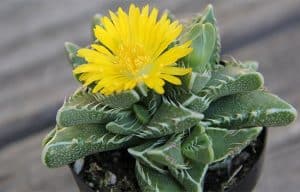
A great plant for both beginners and experienced gardeners alike, Faucaria tigrina ‘Tiger Jaws succulent’ is a medium-sized succulent native to South Africa. A rare example of perfect mimicry, it’s easy to see why nature has spared its life from would-be predators.
Not only does its large yellow flower resemble that of a scrambled egg, but its long brown spines look like mouse tails from afar! It’s important to note that these plants need well-drained soil and require at least 4 hours of sunlight per day.
If you live in an area with cooler temperatures, you can also grow them indoors as long as they receive plenty of natural light. If you choose to grow them indoors, be sure to place them near a window so they can get ample sunlight during daylight hours.
Be aware that if your house is particularly cold, they may not bloom until springtime. They prefer warm climates; however, if you have one of these beauties growing outdoors in a colder climate and it starts to bloom before winter ends, don’t worry, it will simply stop producing flowers until conditions are more favorable again. This doesn’t mean your plant will die; it just means it needs some time to rest up before blooming again.